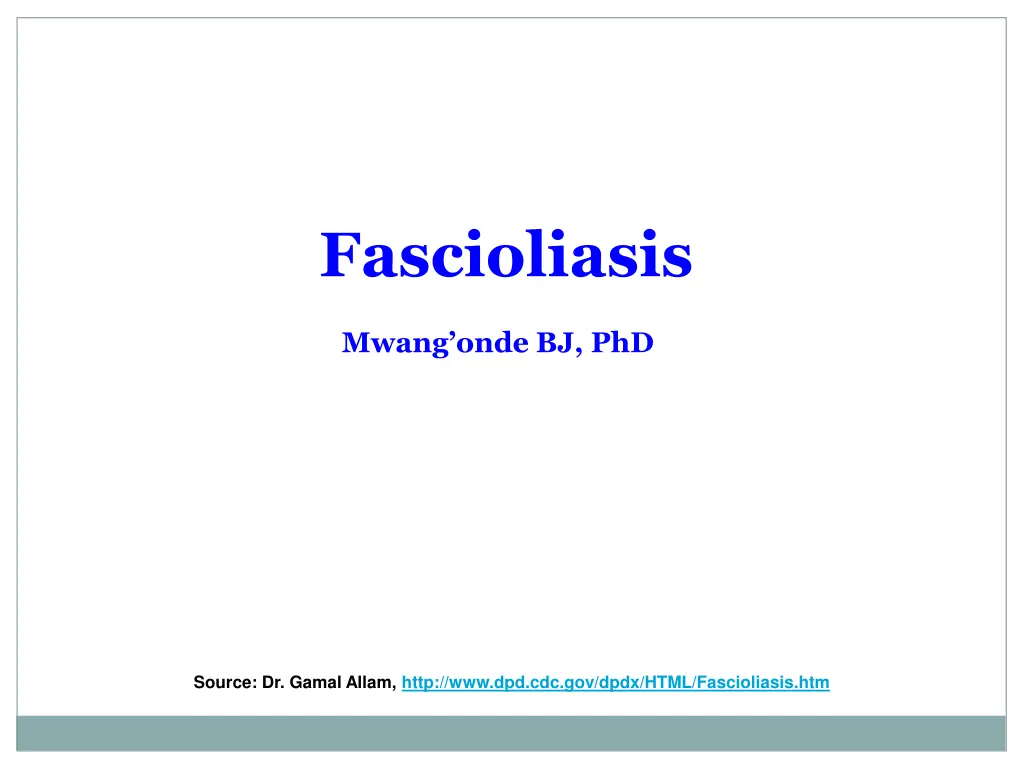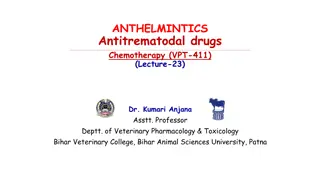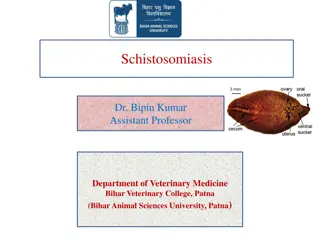
Understanding Fascioliasis: Causes, Symptoms, and Treatment
Learn about fascioliasis, a parasitic disease caused by Fasciola hepatica and Fasciola gigantica. Explore the morphology of the adult parasite, its life cycle, clinical features, and more. Understand how this disease affects humans and animals and discover its impact on health.
Download Presentation

Please find below an Image/Link to download the presentation.
The content on the website is provided AS IS for your information and personal use only. It may not be sold, licensed, or shared on other websites without obtaining consent from the author. If you encounter any issues during the download, it is possible that the publisher has removed the file from their server.
You are allowed to download the files provided on this website for personal or commercial use, subject to the condition that they are used lawfully. All files are the property of their respective owners.
The content on the website is provided AS IS for your information and personal use only. It may not be sold, licensed, or shared on other websites without obtaining consent from the author.
E N D
Presentation Transcript
Fascioliasis Mwang onde BJ, PhD Source: Dr. Gamal Allam, http://www.dpd.cdc.gov/dpdx/HTML/Fascioliasis.htm
Causal Agents Fascioliasis is a parasitic disease caused by Fasciola hepaticaand Fasciola gigantica Parasites of herbivores that can infect humans accidentally Cosmopolitan
Morphology of the adult The adult is leaf-like, about 60 x 15 mm. It has an oral sucker and a larger ventral sucker Male reproductive system begins with two branched testes in the middle of the body The ovary is a branched organ
The ovum is: Size: about 150 x 80 . Shape: Operculated, oval in shape. Colour: Yellow in colour. Content: Contains immature embryo. Dr. Gamal Allam
Life cycle The parasite lives in the bile ducts of man and herbivorous animals which are the definitive hosts The ova pass with bile to the intestine to come out with faeces In water, the ovum needs two weeks to mature and a miracidium come out. It swims in water until it finds the snail intermediate hostLymnaea sp. Inside the snail it metamorphoses into sporocyst then rediae and finally cercariae in about 6 weeks.
The cercariae swim in water and within 2 hours they settle on grass and water plants and even in water where they encyst forming encysted metacercariae ) the infective stage). The encysted metacercaria can keep alive for about 6 months . The definitive host is infected by ingestion of vegetables or water containing the metacercariae. The cyst dissolves in the intestine and the metacercaria finds its way to the liver through the peritoneal cavity and reaches the bile ducts in about 6-8 week.
Life cycle Dr. Gamal Allam
Clinical Features During the acute phase (caused by the migration of the immature fluke through the hepatic parenchyma), manifestations include: abdominal pain, hepatomegaly, fever, vomiting, diarrhea, eosinophilia, and can last for months. In the chronic phase (caused by the adult fluke within the bile ducts), the symptoms are: biliary obstruction, inflammation, liver Rot.
Liver Rot Dr. Gamal Allam
Halzoun syndrome (Pharyngeal fascioliasis): It is a disease characterized by pharyngitis and laryngeal oedema. It is limited to the Middle and Far East. The disease occurs due to adult Fasciola adhering to the posterior pharyngeal wall. The condition is caused by consumption of raw, infected sheep liver
Mode of infection Humans can become infected by ingesting metacercariae-containing freshwater plants or metacercariae- contaminated water. Pharyngeal fascioliasis occur by eating raw infected liver.
Laboratory Diagnosis Microscopic identification of eggs is useful in the chronic (adult) stage. Eggs can be recovered in the stools or in material obtained by duodenal or biliary drainage.
Laboratory Diagnosis.cont. Dr. Gamal Allam
Disease Control Treatment of infected animals. Snail control. Avoid eating raw vegetables before washing them. Avoid drinking infected water. Avoid eating raw liver to prevent halzoun syndrome



















